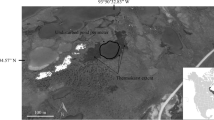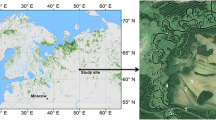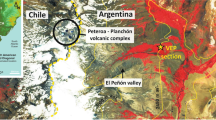Abstract
Permafrost in peatlands of subarctic Sweden is presently thawing at accelerated rates, which raises questions about the destiny of stored carbon and nutrients and impacts on adjacent freshwater ecosystems. In this study we use peat and lake sediment records from the Stordalen palsa mire in northern Sweden to address the late Holocene (5,000 cal BP-present) development of the mire as well as related changes in carbon and nutrient cycling. Formation, sediment accumulation and biogeochemistry of two studied lakes are suggested to be largely controlled by the development of the mire and its permafrost dynamics. Peat inception took place at ca. 4,700 cal BP as a result of terrestrialisation. Onset of organic sedimentation in the adjacent lakes occurred at ca. 3,400 and 2,650 cal BP in response to mire expansion and permafrost aggradation, respectively. Mire erosion, possibly due to permafrost decay, led to re-deposition of peat into one of the lakes after ca. 2,100 cal BP, and stimulated primary productivity in the other lake at ca. 1,900–1,800 cal BP. Carbonate precipitation appears to have been suppressed when acidic poor fen and bog (palsa) communities dominated the catchment mire, and permafrost-induced changes in hydrology may further have affected the inflow of alkaline water from the catchment. Elevated contents of biogenic silica and diatom pigments in lake sediments during periods of poor fen and bog expansion further indicate that terrestrial vegetation influenced the amount of nutrients entering the lake. Increased productivity in the lake likely caused bottom-water anoxia in the downstream lake and led to recycling of sediment phosphorous, bringing the lake into a state of self-sustained eutrophication during two centuries preceding the onset of twentieth century permafrost thaw. Our results give insight into nutrient and permafrost dynamics in a subarctic wetland and imply that continued permafrost decay and related vegetation changes towards minerotrophy may increase carbon and nutrient storage of mire deposits and reduce nutrient fluxes in runoff. Rapid permafrost degradation may on the other hand lead to widespread mire erosion and to relatively short periods of significantly increased nutrient loading in adjacent lakes.







Similar content being viewed by others
References
Alexanderson H, Karlström C, Larsson-Mcann S (1991) Temperaturen ocg nederbören i Sverige 1961–1990. Referencenormaler. Swedish Meteorological and Hydrological Institute. Meteorologi 81, Norrköping
Barnekow L (2000) Holocene regional and local vegetation history and lake-level changes in the Torneträsk area, northern Sweden. J Paleolimnol 23:399–420
Battarbee RW (2000) Palaeolimnological approaches to climate change, with special regard to the biological record. Quat Sci Rev 19:107–124
Blockley SPE, Blaauw M, Bronk Ramsey C, van der Plicht J (2007) Building and testing age models for radiocarbon dates in lateglacial and early Holocene sediments. Quat Sci Rev 26:1915–1926
Bronk Ramsey C (2008) Deposition models for chronological records. Quat Sci Rev 27:42–60
Charman D (2002) Peatlands and environmental change. Wiley, New York, p 301
Christensen TR, Johanson T, Åkerman J, Mastepanov M (2004) Thawing sub-arctic permafrost: effects on vegetation and methane emissions. Geophys Res Lett 31:L04501. doi:10.1029/2003GL018680
Cole JJ, Prairie YT, Caraco NF, McDowell WH, Tranvik LJ, Striegl RG, Duarte CM, Kortelainen P, Downing JA, Middelburg JJ, Melack J (2007) Plumbing the global carbon cycle: integrating inland waters into the terrestrial carbon budget. Ecosystems 10:171–184
Conley DJ, Schelske CL (2001) Biogenic silica. In: Smol JP, Birks HJB, Last WM (eds) Tracking environmental change using lake sediments: biological methods and indicators. Kluwer Academic Press, Dordrecht
Conley DJ, Quigley MA, Schelske CL (1988) Silica and phosphorous flux from sediments: importance of internal recycling in Lake Michigan. Can J Aquat Sci 45:1030–1035
Conley DJ, Likens GE, Buso DC, Saccone L, Bailey SW, Johnson CE (2008) Deforestation caused increased dissolved silicate losses in north temperate hardwood ecosystems. Glob Chang Biol 14:2548–2554
Flower RJ (1993) Diatom preservation: experiments and observations on dissolution and breakage in modern and fossil material. Hydrobiologia 269(270):473–484
Gorham E (1991) Northern peatlands: role in the carbon cycle and probable response to climatic warming. Ecol Appl 1(2):182–195
Grudd H, Briffa KR, Karlén W, Bartholin TS, Jones PD, Kromer B (2002) A 7400-year tree-ring record in northern Swedish Lapland: natural climatic variability expressed on annual to millennial timescales. Holocene 12:657–665
Halsey LA, Vitt DA, Zoltai SC (1995) Disequilibrium response of permafrost in boreal continental western Canada to climate change. Clim Change 30:57–73
Halsey LA, Vitt DA, Trew DO (1997) Influence of peatlands on the acidity of lakes in Northeastern Alberta, Canada. Water Air Soil Pollut 96:17–38
Hughes PDM (2000) A reappraisal of the mechanisms leading to ombrotrophy in British raised mires. Ecol Lett 3:7–9
Hurley JP, Amstrong DE, Kenoyer GJ, Bowser CT (1985) Groundwater as silica source for diatom production in a precipitation-dominated lake. Science 227:1576–1578
Kokfelt U, Rosén P, Schoning K, Christensen TR, Förster J, Karlsson J, Reuss N, Rundgren M, Callaghan TV, Jonasson C, Hammarlund D (2009) Ecosystem responses to increased precipitation and permafrost decay in sub-arctic Sweden inferred from peat and lake sediments. Glob Chang Biol 15:1652–1663
Kullman L (2007) Tree line population, monitoring of pinus sylvestris in the Swedish Scandes 1973–2005: implications for tree line theory and climate change ecology. J Ecol 95:41–52
Kullti M, Mikkola K, Virtanen T, Timinen M, Eronen M (2006) Past changes in the Scots pine forest line and climate in Finnish Lapland: a study based on megafossils, lake sediments and GIS-based vegetation and climate data. Holocene 16:381–391
Lampert W, Sommer U (2007) Limnoecology, the ecology of lakes and streams. Oxford University Press, Oxford, p 324
Limpens J, Heijmans MMPD, Berendsee F (2006) The nitrogen cycle in boreal peatlands. In: Wieder, RK, Vitt DH (eds) Boreal peatland ecosystems. Ecological Studies, vol 188, 435 pp
Lindström M, Bax G, Dinger M, Dworatzek M, Erdtmann W, Fricke A, Kathol B, Klinge H, Pape P, von Stumpf U (1985) Geology of a part of the Torneträsk section of the Caledonian front, northern Sweden. In: Gee DG, Stuart BA (eds) The caledonide orogen—scandinavia and related areas. Wiley, New York, pp 507–513
MacDonald GM, Beukens RP, Kieser WE, Vitt DH (1987) Comparative radiocarbon dating of terrestrial plant macrofossils and aquatic moss from the ice-free corridor of western Canada. Geology 15:837–840
Malmer N, Nihlgård B (1980) Supply and transport of mineral nutrients in a Sub-arctic mire. In: Sonesson M (ed) Ecology of a subarctic mire. Ecological Bulletins, vol 30, pp 63–95
Malmer N, Wallén B (1996) Peat formation and mass balance in subarctic ombrotrophic peatlands around Abisko, northern Scandinavia. In: Karlsson PS, Callaghan TV (eds) Plant ecology in the sub-arctic swedish lapland. Ecological Bulletins, vol 45, pp 79–92
Nilsson A (2006) Limnological responses to late Holocene permafrost dynamics at the Stordalen mire, Abisko, northern Sweden. Unpublished MSc thesis, Department of Geology, Lund University, no 194
Nyholm E (1954–1965) Illustrated moss flora of fennoscandia. II. Musci. CWK Gleerup, Lund
Ohlsson KEA, Wallmark PH (1999) Novel calibration with correction for drift and non-linear response for continuous flow isotope ratio mass spectrometry applied to the determination of δ15N, total nitrogen, δ13C and total carbon in biological material. Analyst 124:571–577
Oksanen PO (2002) Holocene permafrost dynamics in palsa and peat plateau mires of continental Europe. Licentiate thesis, University of Oulu, Finland
Oksanen PO (2005) Development of palsa mires on the northern European continent in relation to Holocene climatic and environmental changes. Doctoral thesis, University of Oulu, Finland
Oksanen PO (2006) Holocene development of the vaisjeäggi palsa mire, finnish lapland. Boreas 35:81–95
Oksanen PO, Kuhry P (2003) Permafrost induced changes in the hydrology and ecology of mires, ecohydrological processes in Northern Wetlands. Selected papers of International Conference and Educational Workshop, Tallin, Estonia: 92–98
Olsrud M (2004) Mechanisms of below-ground carbon cycling in a sub-arctic ecosystem. Doctoral thesis, Lund University, Sweden
Reimer PJ, Baillie MGL, Bard E, Bayliss A, Beck JW, Bertrand C, Blackwell PG, Buck CE, Burr G, Cutler KB, Damon PE, Edwards RL, Fairbanks RG, Friedrich M, Guilderson TP, Hughen KA, Kromer B, McCormac FG, Manning S, Bronk Ramsey C, Reimer RW, Remmele S, Southon JR, Stuiver M, Talamo S, Taylor FW, van der Plicht J, Weyhenmeyer CE (2004) IntCal04 terrestrial radiocarbon age calibration, 0–26 cal kyr BP. Radiocarbon 46(3):1029–1059
Reuss N, Conley DJ (2005) Effects of sediment storage conditions on pigment analyses. Limnol Oceanogr Methods 3:477–487
Seppälä M (1986) The origin of palsas. Geografiska annaler, Series A. Phys Geogr 68:141–147
Seppälä M (2003) Surface abrasion of palsas by wind action in Finnish Lapland. Geomorphology 52:141–148
Skog G (2007) The single stage AMS machine at Lund University: status report. Nucl Instrum Methods Phys Res B 259:1–6
Snowball I, Sandgren P (1996) Lake sediment studies of Holocene glacial activity in the Kårsa valley, northern Sweden: contrasts in interpretation. Holocene 6(3):367–372
Sonesson M (1966) On Drepanocladus trichophyllus in the Torneträsk area. Botaniska Notitser 119:379–400
Sonesson M (1970a) Studies on mire vegetation in the Torneträsk area northern Sweden III. Communities of the poor mires. Opera Botanica 26:1–120
Sonesson M (1970b) Studies on mire vegetation in the Torneträsk area, northern Sweden. IV. Some habitat conditions of the poor mires. Botaniska notitser 123:67–111
Sonesson M (1972) Cryptogams. In: International biological programme—Swedish tundra biome project. Technical report No. 9, April 1972. Swedish Natural Science Research Council Ecological Research Committee
Sonesson M (1974) Late quaternary forest development of the Torneträsk area, North Sweden. 2. Pollen analytical evidence. Oikos 25:288–307
Sonesson M (1980) Ecology of a subarctic mire. Ecol Bull 30:1–315
Street-Perrot FA, Barker PA, Leng MJ, Sloane HJ, Wooler MJ, Ficken FK, Swain DL (2008) Towards an understanding of late quaternary variations in the continental biogeochemical cycle of silicon: multi-isotope and sediment-flux data for Lake Rutundu, Mt Kenya, East Africa, since 38 ka BP. J Quat Sci 23(4):375–387
Ström L (1997) Root exudation of organic acids: importance to nutrient availability and the calcifuge behaviour of plants. Oikos 80:459–466
Struyf E, Conley DJ (2009) Silica: an essential nutrient in wetland biogeochemistry. Front Ecol Environ 7(2):88–94
Svensson G (1988) Bog development and environmental conditions as shown by the stratigraphy of store mosse mire in southern Sweden. Boreas 17:89–111
van Bremen N (1995) How sphagnum bogs down other plants. Trends Ecol Evol 10:270–275
Vardy SR, Warner BG, Aravena R (1998) Holocene climate and the development of a subarctic peatland near Inuvik, Northwest Territories, Canada. Clim Change 40:285–313
Walbridge MR, Navaratnam JA (2006) Phosphorous in boreal peatlands. In: Wieder RK, Vitt DH (eds) Boreal peatland ecosystems. Ecological Studies, vol 188, pp 231–258
Zuidhoff F, Kolstrup E (2000) Changes in palsa distribution in relation to climate change in Laivadalen, northern Sweden, especially 1960–1997. Permafrost Periglac 11:55–59
Acknowledgments
Funding was provided by the Swedish Research Council (grant to DH). We thank Johannes Förster and Anders Nilsson for laboratory and fieldwork assistance, Daniel Conley for providing facilities to analyse BSi on the lake sediments and Lena Barnekow, Linda Randsalu, Johan Rydberg and Ian Snowball for laboratory assistance. The staff at the Abisko Scientific Research Station is acknowledged for providing logistical support. We thank Isabelle Larocque-Tobler and two anonymous reviewers for helpful comments.
Author information
Authors and Affiliations
Corresponding author
Electronic supplementary material
Below is the link to the electronic supplementary material.
Rights and permissions
About this article
Cite this article
Kokfelt, U., Reuss, N., Struyf, E. et al. Wetland development, permafrost history and nutrient cycling inferred from late Holocene peat and lake sediment records in subarctic Sweden. J Paleolimnol 44, 327–342 (2010). https://doi.org/10.1007/s10933-010-9406-8
Received:
Accepted:
Published:
Issue Date:
DOI: https://doi.org/10.1007/s10933-010-9406-8




